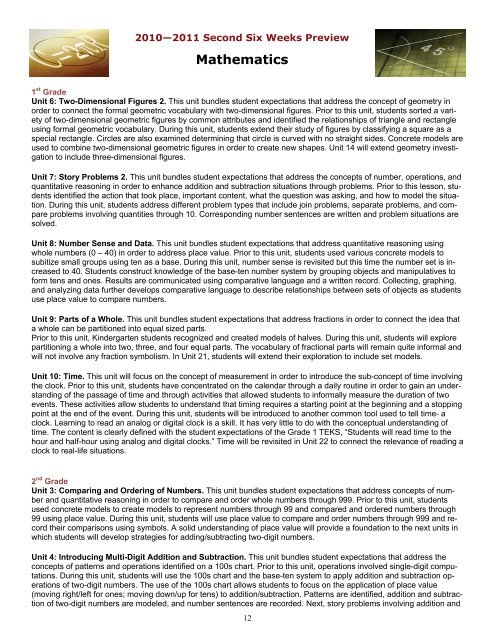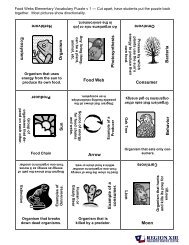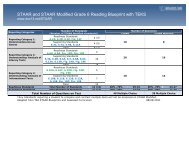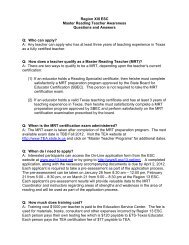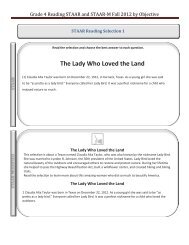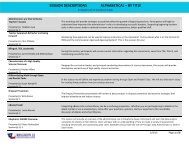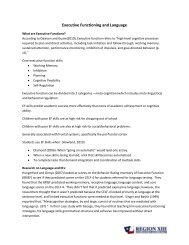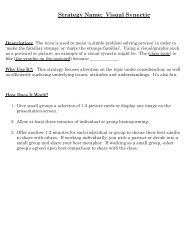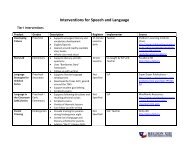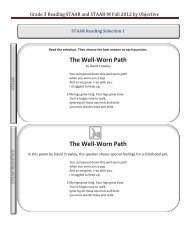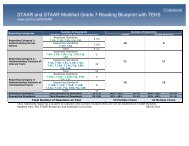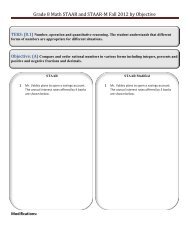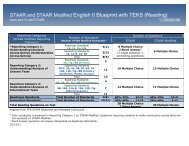2nd Six Weeks Newsletter - Region 13
2nd Six Weeks Newsletter - Region 13
2nd Six Weeks Newsletter - Region 13
Create successful ePaper yourself
Turn your PDF publications into a flip-book with our unique Google optimized e-Paper software.
2010—2011 Second <strong>Six</strong> <strong>Weeks</strong> PreviewMathematics1 st GradeUnit 6: Two-Dimensional Figures 2. This unit bundles student expectations that address the concept of geometry inorder to connect the formal geometric vocabulary with two-dimensional figures. Prior to this unit, students sorted a varietyof two-dimensional geometric figures by common attributes and identified the relationships of triangle and rectangleusing formal geometric vocabulary. During this unit, students extend their study of figures by classifying a square as aspecial rectangle. Circles are also examined determining that circle is curved with no straight sides. Concrete models areused to combine two-dimensional geometric figures in order to create new shapes. Unit 14 will extend geometry investigationto include three-dimensional figures.Unit 7: Story Problems 2. This unit bundles student expectations that address the concepts of number, operations, andquantitative reasoning in order to enhance addition and subtraction situations through problems. Prior to this lesson, studentsidentified the action that took place, important content, what the question was asking, and how to model the situation.During this unit, students address different problem types that include join problems, separate problems, and compareproblems involving quantities through 10. Corresponding number sentences are written and problem situations aresolved.Unit 8: Number Sense and Data. This unit bundles student expectations that address quantitative reasoning usingwhole numbers (0 – 40) in order to address place value. Prior to this unit, students used various concrete models tosubitize small groups using ten as a base. During this unit, number sense is revisited but this time the number set is increasedto 40. Students construct knowledge of the base-ten number system by grouping objects and manipulatives toform tens and ones. Results are communicated using comparative language and a written record. Collecting, graphing,and analyzing data further develops comparative language to describe relationships between sets of objects as studentsuse place value to compare numbers.Unit 9: Parts of a Whole. This unit bundles student expectations that address fractions in order to connect the idea thata whole can be partitioned into equal sized parts.Prior to this unit, Kindergarten students recognized and created models of halves. During this unit, students will explorepartitioning a whole into two, three, and four equal parts. The vocabulary of fractional parts will remain quite informal andwill not involve any fraction symbolism. In Unit 21, students will extend their exploration to include set models.Unit 10: Time. This unit will focus on the concept of measurement in order to introduce the sub-concept of time involvingthe clock. Prior to this unit, students have concentrated on the calendar through a daily routine in order to gain an understandingof the passage of time and through activities that allowed students to informally measure the duration of twoevents. These activities allow students to understand that timing requires a starting point at the beginning and a stoppingpoint at the end of the event. During this unit, students will be introduced to another common tool used to tell time- aclock. Learning to read an analog or digital clock is a skill. It has very little to do with the conceptual understanding oftime. The content is clearly defined with the student expectations of the Grade 1 TEKS, “Students will read time to thehour and half-hour using analog and digital clocks.” Time will be revisited in Unit 22 to connect the relevance of reading aclock to real-life situations.2 nd GradeUnit 3: Comparing and Ordering of Numbers. This unit bundles student expectations that address concepts of numberand quantitative reasoning in order to compare and order whole numbers through 999. Prior to this unit, studentsused concrete models to create models to represent numbers through 99 and compared and ordered numbers through99 using place value. During this unit, students will use place value to compare and order numbers through 999 and recordtheir comparisons using symbols. A solid understanding of place value will provide a foundation to the next units inwhich students will develop strategies for adding/subtracting two-digit numbers.Unit 4: Introducing Multi-Digit Addition and Subtraction. This unit bundles student expectations that address theconcepts of patterns and operations identified on a 100s chart. Prior to this unit, operations involved single-digit computations.During this unit, students will use the 100s chart and the base-ten system to apply addition and subtraction operationsof two-digit numbers. The use of the 100s chart allows students to focus on the application of place value(moving right/left for ones; moving down/up for tens) to addition/subtraction. Patterns are identified, addition and subtractionof two-digit numbers are modeled, and number sentences are recorded. Next, story problems involving addition and12


